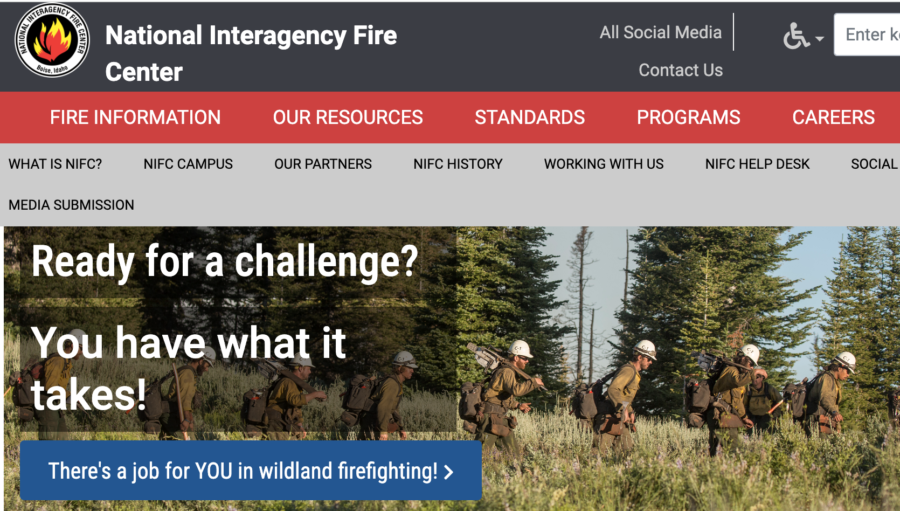“All open federal firefighting jobs are posted at usajobs.gov and applications must be submitted online. At USAJobs, you can search for these positions using the terms ‘forestry technician’ or ‘wildland firefighter.’ The search will return all firefighting positions open for application within both the Department of the Interior and the Agriculture Department.”
The National Interagency Fire Center (nifc.gov) has this and more information online, and the Forest Service has many inspirational videos online explaining the benefits of a “career” as a firefighter.
“The majority of firefighter positions are seasonal in nature,” according to NIFC, “with a typical season lasting from May to September or October. If you are interested in one of these positions, you will need to begin looking and applying for these jobs several months prior, typically in November through early January, as the hiring process can be lengthy.”
What the people at NIFC don’t tell you is why the applicant numbers have fallen off this year — again — badly enough that some hotshot crews may not be able to send out a full crew, some engines are unstaffed, and IMTs are having trouble filling positions and are even considering combining T1 with T2 positions to make up a fully staffed team.
USFS hiring officials say that only about 6,000 applications were submitted for fire positions and close to 11,000 applications for non-fire positions — before any sort of qualification check is run on the applicants. Announcements for temp seasonal positions have been extended to November 13; they were set to close November 8, but the agency has had very low numbers on all announcements nationwide. High school students who are currently 17 but will be 18 by the start dates next spring are encouraged to apply, and numbers of applicants for Forest Service jobs now are so low that chances of a hire are pretty good.

Most of the current openings are for temporary low-pay seasonal jobs. AND — new this year — seasonals will be drug tested. Used to be just permanent hires were, and this new barrier to employment probably has nothing to do with the falling numbers of applicants and other recruitment difficulties. In the table above, most of those with no wage listed are paid on an annual salary basis or are permanent jobs. New applicants with no experience who are willing to move anywhere and really rough it can probably get on this year.
And really rough it might mean living in your car or your own tent dozens of miles from the nearest “town” which is dozens of miles from a real town. They say that doing without the basics will build character, but it can also build issues with your physical and mental health.
Then there’s pay — or the lack of it. Fast-food workers in California are now paid a minimum of $20 an hour. The U.S. sent over $3.3 billion in foreign assistance to Israel in 2022, and $1.4 billion to Afghanistan, but starting jobs for federal firefighters in the U.S. still pay about 16 bucks, and far too many of those firefighters can’t afford even basic housing.
This is by no means a new issue. Nearly three years ago in the spring of 2021, Bill Gabbert wrote that hundreds of permanent firefighting positions were vacant — just in California. The agency’s difficulties back then in recruiting and hiring seasonal and permanent firefighters meant that multiple hotshot crews did not qualify to respond to a fire with 18 personnel — the minimum required by interagency standards.
“More than a dozen FS fire engines in the state are completely unstaffed,” he wrote, “or instead of seven days a week coverage they have cut back to only five. Thirty modules of FS hand crews, dozers, or water tenders in California have been shut down due to a shortage of employees.” He said then that the gaps in staffing were caused by two main factors — difficulty in hiring new personnel, and loss of experienced firefighters leaving the agency for better pay and working conditions elsewhere.
From a report released May 13, 2021 by the Incident Workforce Development Group (IWDG):
Today, critical challenges in rostering and managing IMTs is leading to a decrease in the number of teams available for an increasing number of complex incidents.
In the past five years there have been multiple occasions where all available IMTs have been assigned to large fires. Local units have had to face the consequences of managing a complex incident without the services of an IMT.
The situation now has certainly not improved since 2021; fire season is not likely to somehow get cooler and shorter in 2024 and there’s not likely to be a big pay raise either.
For 2022 the IWDG reported that we had just over 3,500 IMT members, with 1,140 of them classed as Command & General Staff.

The real eye-opener is team membership by agency. Unless other federal and state agencies are going to greatly boost their personnel numbers on the federal incident management teams, the drops in USFS hires may put a serious pinch on the numbers (and qualifications) of those teams.

State and local government employees account for not quite 25 percent of IMT members, and AD hires account for about 17 percent.
A diminished capacity in fielding and assigning IMTs for megafires (and/or those that threaten major clusters of residential areas, e.g. the 2018 Camp Fire or the 2020 Labor Day fires) will mean that the burden will fall more on local and state resources for management of those fires, which in many cases will mean larger fires and larger safety risks for crews, aircraft, and other resources — not to mention local residents.

